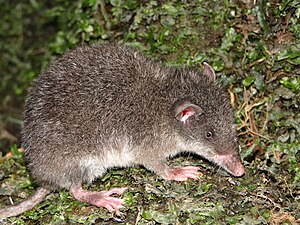Sangay possum mouse
| Sangay possum mouse | ||||||||||||
|---|---|---|---|---|---|---|---|---|---|---|---|---|

Sangay opossum mouse ( Caenolestes sangay ) |
||||||||||||
| Systematics | ||||||||||||
|
||||||||||||
| Scientific name | ||||||||||||
| Caenolestes sangay | ||||||||||||
| Barbour , Pinto , Brito , Albuja , Lee Jr. & Patterson , 2013 |
The Sangay-Opossummaus ( Caenolestes sangay ) is a type of authentics Opossummäuse within the shrew opossum (Caenolestidae). It was only described in 2013 and so far is only known from the Sangay National Park in Ecuador , after which it was named.
features
The Sangay Opossummaus reaches a total length of 216 to 260 millimeters with a head-trunk length of 99 to 137 millimeters and a tail length of about 95 to 130 millimeters, the weight is about 40 grams. The back is brown-gray. The base of the hair on the abdomen is gray, the tips are light, so that the overall color of the abdomen is cream-colored to light, and there is no chest spot. The tail is densely covered with short hairs, dark on top and brown on the underside. The species differs from its relatives morphologically mainly in the large palatal bone opening and the diastema between the external incisor (I4) and the canine (C).
habitat
All specimens of the Sangay opossum mouse caught so far come from 2050 to 3500 high-altitude cloud and cloud forests on the eastern slope of the Andes in Ecuador , a region with a high proportion of endemic species. The species appears to be rare and occurs both on steep slopes and on flat sections of their habitat.
Other occurring in the same habitat and the Sangay-Opossummaus sympatric living small mammals are three different types of Paramo mice ( Thomasomys ), the rice rat Nephelomys albigularis that small Treis rat Microryzomys minutus and two types of the South American field mice ( Akodon ).
The stomachs of the specimens examined for the first description contained remains of insects and plants, including the larva of a click beetle , a wolf spider , a wasp , two-winged wings and black hair, fruits, moss and rhizomes , as well as a flatworm , which was possibly an endoparasite .
literature
- Reed Ojala-Barbour, C. Miguel Pinto, Jorge Brito M., Luis Albuja V., Thomas E. Lee, Jr. and Bruce D. Patterson. 2013. A new species of shrew-opossum (Paucituberculata: Caenolestidae) with a phylogeny of extant caenolestids. Journal of Mammalogy . 94 (5): 967-982. doi: 10.1644 / 13-MAMM-A-018.1